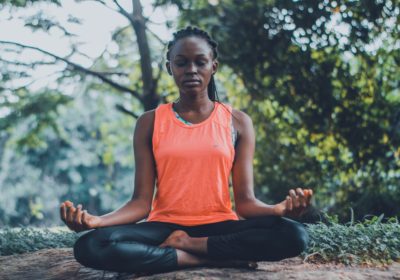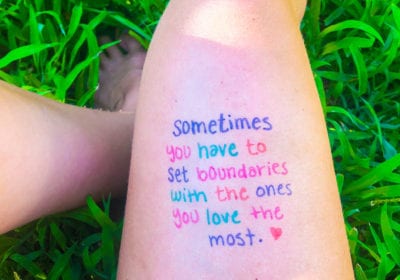9 Simple Mindfulness Activities for Adults
I never understood how lost in thought I was until I learned how to be mindful. Mindfulness is the state of being aware without judgment. It is a simple activity that allows for total immersion in the present moment.
With these 9 mindfulness activities for adults, you too can learn how to sprinkle mindful moments throughout your day.
Want a convenient place to return to these exercises? Download the eBook here.
Mindfulness, as noted by the American Psychology Association, is empirically proven to reduce stress, rumination, and emotional reactivity while boosting working memory and focus.
Contrary to popular belief, mindfulness is not the absence of thought. Instead, it is the complete awareness and acceptance of everything as it is, including thoughts, feelings, and sensations.
Jack Kornfield, who has taught meditation internationally since 1974, explains 3 different types of mindfulness.
- Being intimately aware of a specific sensation or experience
- As the observer of experience
- As the witness of the observer of experience
Here we outline 9 mindfulness activities for adults that help gradually expand your capacity to be present. (Listed from the most basic to the most advanced.)
- Present Moment, Wonderful Moment Breathing
- 4-7-8 Breath
- Paying Attention to Sound
- Bell or Chime Calming
- Five Senses Exercise
- Body Scan Grounding Technique
- Mindful Eating
- Mindful Walking
- Mindful Pausing
- Using Transition Moments Mindfully
This article also contains affiliate links which means chill chief makes a small commission at no extra cost to you if you buy through one of the links.

Present Moment, Wonderful Moment Breathing
This simple breathing and awareness technique comes from Thich Nhat Hanh’s book “Peace Is Every Step.” (This book also made the best mindfulness books for beginners list.) Thich Nhat Hahn is a Zen Meditation Master and peace activist who assisted in bringing meditation to the western world.
The “present moment, wonderful moment breathing” aligns thoughts with each inhale and exhale. The mind slows down to focus on one specific unifying task. The mindfulness exercise also increases feelings of connection, warmth, joy, and openness.
To perform this exercise, repeat the following phrases while inhaling and exhaling.
- Inhale – Breathing In, I calm my body.
- Exhale – Breath out, I smile.
- Inhale – Dwelling in the present moment,
- Exhale – I know this is a wonderful moment!
You can also shortened the phrases to “Calming, Smiling, Present Moment, Wonderful Moment.”
Quick “How to”: Breath and repeat these phrases. Inhale “Calming” Exhale “Smiling” Inhale “Present Moment” Exhale “Wonderful Moment”
How do I use this technique? Often, I use this practice while walking with my dog, between transitional moments at work, and when I feel anxiety bubbling up. This practice was one of the first mindfulness exercises I ever started using. If you want to know more about my journey you can read about it here.

4-7-8 Breath
The 4-7-8 breath was originally a pranayama (yoga) breath and is one of my favorite mindfulness activities for adults. This technique was further developed by Dr. Weil, director of the Andrew Weil Center for Integrative Medicine at the University of Arizona, clinical professor of medicine, and professor of public health.
The primary intent of this exercise is to calm the nervous system in times of stress.
Start by sitting or lying down. Place the tip of your tongue on the roof of your mouth right behind your teeth. Push all the existing air out of your lungs before beginning.
- Breathe quietly in through your nose for a count of 4
- Hold your breath for a count of 7
- Breathe forcefully out of your mouth (with the tip of your tongue on the roof of your mouth) for a count of 8 while making a “whooshing” sound
- Repeat for 4 breath cycles
The speed of the exercise does not matter as long as you keep the tempo steady.
Dr. Weil recommends practicing 2 times a day for 4 to 6 weeks before attempting to use this breathing technique to calm the nervous system during a specific situation.
Quick “How To”: Sit or lay down. Place tongue on the roof of the mouth. Exhale before beginning. Breathe in through the nose for 4. Hold the breath for a count of 7. Breathe forcefully out the mouth, making a whooshing sound for a count of 8. Repeat 4 breath cycles twice a day.
How do I use this technique? I have personally used this technique to avoid a panic attack. If you want to learn all the details on how and when to use this technique for high-stress situations, you can find the article here.
Remember, you can download the eBook here if you want to conveniently return to these exercises.

Paying Attention to Sound
My personal favorite is mindful hearing. Working with sounds can often bring about an expansive and spacious kind of awareness.
Sam Harris introduces the art of paying attention to sound on his app Waking Up. Sam has a Ph.D. in neuroscience and has studied meditation for over 30 years.
The steps to paying attention to sound in a mindful way can be practiced anytime and in any location.
- Sit, stand, or lay down in a comfortable position.
- Close your eyes to focus more closely on sound.
- Listen carefully as every sound rises and falls away.
- Notice each sounds exact quality as it passes through your awareness.
Advanced: If a thought arises, do not push it away but rather watch it unfold as if it were another passing sound, then return to external noises.
Once you feel comfortable with focusing on sound you can begin to become more familiar with the similar quality of the rise and fall of thought.
Quick “How To”: Get comfortable. Close your eyes. Listen carefully to every sound that arises. Treat thoughts the same as any external sound.
How do I use this technique? I use this mindfulness activity often – when feeling stressed at work, to get closer to an enjoyable moment, or to give my mind a second to rest when I feel overwhelmed. In formal sitting meditation, sound is often my anchor rather than the traditional breath anchor.

Bell or Chime Calming
Typically at the beginning of a traditional meditation or yoga session, the teacher will use a singing bowl to start the session. These bowls have a thick edge that makes a ringing noise when slowly circled by a wooden stick or struck on the side.
In Plum Village, a Buddhist Monastery founded by Thich Nhat Hahn, a daily bell chimes and everyone in the village stops whatever they are doing just to listen.
To practice this activity, purchase an instrument to provide the sound – some objects you may consider are a set of bells, tingsha bells, or a singing bowl. At least once a day step over to your instrument and ring it. Now stop all activities and listen until the sound fades away.
Quick “How To”: Buy an instrument that creates a ringing sound. Ring it once a day. Stop all other activities and listen to it intently as it rings.
How do I use this technique? Many of the recent meditations and yoga sessions I have performed begin with the ringing of a singing bowl. This is a simple mindfulness activity for adults to practice in the comfort of their homes.

Five Senses Exercise
The “Five Senses Exercise” is a grounding technique that uses all five senses to root down and feel entirely centered in the body. It encourages the brain to refocus from ruminating thought to right-now happenings.
- FEEL – Name 5 sensations that you can feel in your body. For example, my shirt against my skin, the chair pressing into my heel, or an itch behind my shoulder.
- HEAR – Name 4 things you can hear. For example, a dog barking nearby, the sound of cars passing or the air conditioning running.
- SEE – Name 3 things that you can see. For example, a red dog leash, a lavender bush, or an office desktop.
- SMELL – Name 2 things you can smell. For example, fresh air, wooded trees, or asphalt.
- TASTE – Name one thing you can taste. For example, leftover cookie crumbs, toothpaste, or morning breath.
Remember that nothing you name here is wrong. This is not a test but instead an activity that can help guide you back to the present.
Quick “How To”: Name 5 things you can feel, 4 things you can hear, 3 things you can see, 2 things you can smell and 1 thing you can taste.
How do I use this technique? I use this technique daily – most of the time, when I am at work. If you want to learn how to use this technique in a less conceptual and more meditative way, you can do so here.
Remember, you can download the eBook here if you want to conveniently return to these exercises.

Body Scan Grounding Mindfulness Activity
Paying attention to sensations acts as a grounding technique to relax the mind and draw attention to feeling alive in the body.
The body scan technique is commonly used at the start of a mindfulness meditation session.
Sit or lie down in a comfortable position. Close your eyes to reduce the number of stimuli. Start at the top of your head and work all the way down to your feet. Pay close attention to what each area of the body feels like. Tara Brach, psychologist and meditation leader, explains it as “feeling from the inside out.”
It can be difficult at first for many people to feel much below the shoulders. Any feeling (or no feeling) is entirely okay.
Quick “How To”: Get into a comfortable position. Close eyes. Pay attention to sensations in each part of the body. Start at the top of the head and work to the toes.
How do I use this technique? I use this technique when my thoughts are racing, and I want to feel more grounded.

Mindful Eating
Many of us use food only as a tool for nourishment, but it can also be used as a tool for mindfulness.
Many people eat in front of the television or during a full-on conversation. Instead, eating can be used as a time to pay close attention to food and the sensory experience it creates.
To set up this experience, eat food somewhere away from the TV or with the TV turned off and make others nearby aware of your intention to speak minimally.
- Pay close attention to the aroma of your food.
- Take close consideration of how the food appears.
- With each bite, become aware of how the food feels in your mouth.
- Mentally note how each flavor tastes on your tongue.
This action allows for the authentic experience and pure enjoyment of eating. It promotes a healthier relationship with food and the nourishment it offers.
Quick “How To”: Eat away from the TV or other distractions. Pay close attention to the sensory experience of eating – smell, look, feel, taste.
How do I use this technique? I am not the best at executing this technique as I am a culprit of the TV dinner and computer lunch. Though in my minimal practice, I have found it incredibly enjoyable.

Mindful Walking
“When you walk, arrive with every step. That is walking meditation. There’s nothing else to it.” Thich Nhat Hahn, book How to Walk
Thich Nhat Hahn believes in the magic of mindful walking, so much so that he wrote an entire book on it called How to Walk.
Mindful walking is effortless and allows you to become very close to the experience of walking, breathing, and smiling. Walking without a physical destination but instead to arrive in the present moment with “concentration, joy, insight, and the momentary enlightenment of aliveness.” (1)
To begin this practice begin walking with no specific destination. Move leisurely without rushing and notice each foot touch the ground. Pay attention to your inhales and exhales.
If you want to add an additional layer to this practice, you can recite the “Present Moment, Wonderful Moment Breathing” while walking. No need to time your breaths and steps together.
Quick “How To”: Walk with no destination. Focus on your feet as they touch the ground, bodily sensations, and your breath.
How do I use this technique? I pair this technique with the “Present Moment, Wonderful Moment Breathing” exercise. I am continually amazed at the gratitude, joy, and connection I feel with passing strangers when practicing this meditation.
Remember, you can download the eBook here if you want to conveniently return to these exercises.

Mindful Pausing
Jon Kabat Zinn describes mindfulness as, “…paying attention in a particular way: on purpose, in the present moment, and nonjudgmental.”
Jon was a professor of medicine and the creator of the Stress Reduction Clinic and the Center for Mindfulness in Medicine, Health Care, and Society at the UMass Medical School. He studied under many Zen Meditation Masters eventually pioneering Mindfulness-Based Stress Reduction (MBSR).
Once you learn how to invoke an attitude of mindfulness, you can begin to use these techniques when intense emotions arise.
To perform this technique, first, become aware of a negative or painful emotion. For example, annoyance while stuck in traffic or anger at a coworker. After becoming aware, pause and allow. Without reaction, observe the feeling kindly and without judgment. Return to the present moment through the breath, sounds, or sensations. Now, respond.
Mindful pausing is the act of stepping between the stimuli and a reaction. A pause which allows you to respond to a situation rather than react.
Quick “How To”: Become aware of negative emotion. Pause and allow. Observe the feeling without judgment. Return to the present moment. Respond.
How do I use this technique? The most impactful use of this exercise has been during a triggering conversation with a loved one of mine. Instead of reacting out of hurt and anger, I was able to respond with compassion and understanding.

Using Transition Moments Mindfully
Every day, we have an uncountable amount of transitional moments – for instance, walking into work, waiting on the elevator, or moving between activities. Each moment has the infinite potential to be experienced fully.
Next transition moment, bring this practice to the front of your mind. Starting out with one specific transition may help recall this practice more easily. Intently concentrate on any sensation, sound, thought, feeling, or sensory experience that arises.
Expand this to multiple transitional experiences to litter your day with little moments of mindfulness, presence, and joy.
Quick “How To”: Select one transition moment to start. Focus on any internal or external experience that arises. Breath and smile.
How do I use this technique? The transition moments I first began practicing with was moving between my car and office building – about a ten-minute walk. It helps me both start and end my workday with a sense of wholeness.
If these mindfulness exercises for adults were helpful to you, download the eBook to have them at the palm of your hand whenever you need a refresher.
Mindfulness Activities FAQ
There are many mindfulness activities. But 5 to consider are paying attention to the breath, mindful walking, mindful eating, listening closely to sound, and performing a body scan.
Mindfulness activities are anything that helps train attention to focus on the present moment, non-judgmentally. One example could be eating slowly and intentionally, focusing on every sensation and flavor. Another example could be going for a walk and focusing closely on the sensations of rolling through the feet, moving the legs, and feeling the breath come and go.
Formal meditation helps teach the mind to reside in the present moment, but mindfulness can also be practiced informally in everyday life. To practice informally simply relax the mind and allow it to be open, notice whenever you are lost in thought and return back to sensations in the body or sounds around you. This can be done during many daily activities like eating, walking, waiting, working out, or spending time with loved ones.
Adults can learn mindfulness in many ways – but adopting a formal sitting meditation practice is a great way to start. Two ways this can be done is by downloading a meditation app with a beginner’s course (like the Waking Up App), or joining an online or nearby sangha (like Spirit Rock).
One of the most basic mindfulness techniques is focusing on the rise and fall of the natural breath and noticing the sensations associated with it. Two other basic techniques are a body scan (which is slowing scanning the body and noticing sensations throughout) and listening closely to sounds.




[…] stress is determined by the number of life experiences an individual considers stressful. Mindfulness is a quality of being aware in the present moment without judgment. Reducing perceived stress and […]